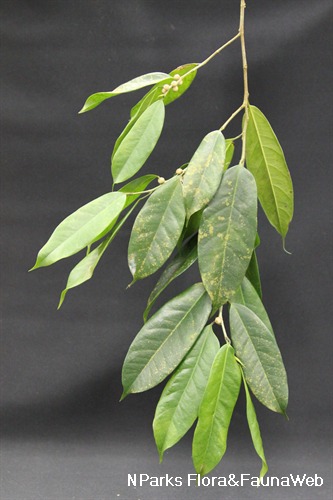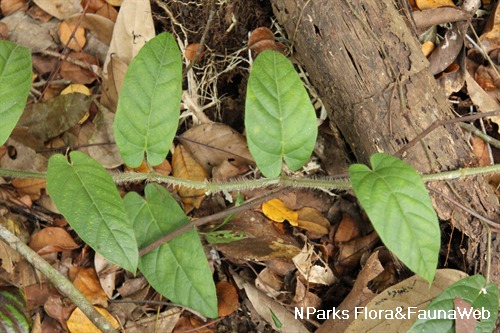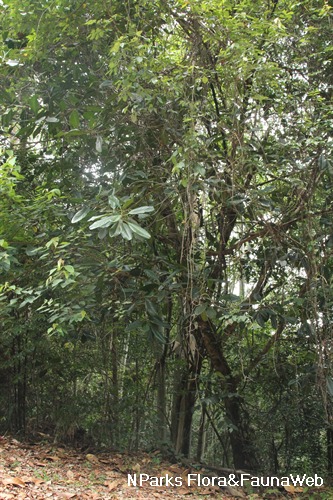
Name
Classifications and Characteristics
| Plant Division | Angiosperms (Flowering Seed Plants) (Dicotyledon) |
|---|---|
| Plant Growth Form | Climber |
| Lifespan (in Singapore) | Perennial |
| Mode of Nutrition | Autotrophic |
| Plant Shape | Irregular |
Biogeography
| Native Distribution | North-eastern India, Andaman Islands, southern China, Myanmar, Indochina, Thailand, Sumatra, Peninsular Malaysia, Singapore, the Philippines, Borneo, Java, Sulawesi, and the Moluccas. |
|---|---|
| Native Habitat | Terrestrial (Primary Rainforest, Secondary Rainforest, Monsoon Forest, Freshwater Swamp Forest) |
| Preferred Climate Zone | Tropical, Sub-Tropical / Monsoonal |
| Local Conservation Status | Native to Singapore (Endangered (EN)) |
Description and Ethnobotany
| Growth Form | It is a latex-containing, root-climbing fig covered with soft hairs on its vegetative parts. Young plants typically creeping prostrately up trunks or on ground. Mature plants may dangle vine-like stems across trunks and shrubs. |
|---|---|
| Foliage | Its alternate, stalked leaves have thickly leathery leaf blades that are 9–30 by 4.5–11 cm, elliptical to ovate, with rounded or slightly heart-shaped bases when matured, and sunken venation on its upper surfaces. Its young leaves have leaf blades that are very hairy, and softer, red to greenish orange. |
| Stems | Woody, flexible, covered with fine hairs, inconspicuously hidden behind leaves. All parts oif plant leak white latex when bruised. |
| Flowers | Tiny, cream-coloured, massed together on inside of syconium wall. Syconia produced in clusters on stem nodes and leaf axils. Species is dioecious, with male and female flowers found on separate plants. Flowers pollinated by symbiont fig wasps. |
| Fruit | Orange figs are round, beaked fruits. |
| Habitat | It grows in hill to lowland forests up to 1,700 m altitude. It is known locally from Nee Soon Swamp Forest, Bukti Timah Nature Reserve, Central Catchment Nature Reserve, and Pulau Ubin. |
| Associated Fauna | Its flowers are pollinated by fig wasps. The ripe fruits are eaten by frugivorous birds and mammals. |
| Cultivation | Slow-growing, takes full sun to semi-shade. Provide moist media and humidity. Relatively easy to maintain once established. Propagate by seeds or cuttings. |
| Etymology | Genus epithet 'Ficus' derived from Latin name for edible fig Ficus carica. Species epithet 'villosa' means covered by long soft hairs, a reference to the plant's furry leaves, stems and fruits. |
Landscaping Features
| Landscaping | Its twigs, leaves and figs are covered with soft hairs. It is suitable for gardens or parks to climb on trees. |
|---|---|
| Desirable Plant Features | Ornamental Foliage, Ornamental Fruits |
| Landscape Uses | Vertical Greenery / Green Wall, Terrarium, Parks & Gardens, Small Gardens |
| Thematic Landscaping | Naturalistic Garden |
| Usage Hazard - Cons | Irritant - Sap |
Fauna, Pollination and Dispersal
| Fauna Pollination Dispersal Associated Fauna | Bird-Attracting (Fruits) |
|---|---|
| Pollination Method(s) | Biotic (Fauna) (Insects (Ant, Beetle, Fly, Thrip, Wasp)) |
| Seed or Spore Dispersal | Biotic (Fauna) (Vertebrates (Bat), Vertebrates (Other Mammal)) |
Plant Care and Propagation
| Light Preference | Full Sun, Semi-Shade, Full Shade |
|---|---|
| Water Preference | Moderate Water |
| Plant Growth Rate | Slow |
| Rootzone Tolerance | Fertile Loamy Soils, Well-Drained Soils, Moist Soils, Shallow Media |
| Maintenance Requirements | Moderate |
| Propagation Method | Seed, Stem Cutting |
Foliar
| Foliage Retention | Evergreen |
|---|---|
| Mature Foliage Colour(s) | Green |
| Mature Foliage Texture(s) | Velvety / Furry / Tomentose, Hairy / Hirsute, Leathery, Raised / Sunken Veins, Thick |
| Prominent Young Flush Colour(s) | Red, Orange |
| Young Flush Texture(s) | Hairy / Hirsute |
| Foliar Type | Simple / Unifoliate |
| Foliar Arrangement Along Stem | Alternate |
| Foliar Attachment to Stem | Petiolate |
| Foliar Shape(s) | Non-Palm Foliage (Ovate, Cordate, Elliptical) |
| Foliar Venation | Pinnate / Net |
| Foliar Margin | Entire |
| Foliar Apex - Tip | Acute |
| Foliar Base | Cordate |
| Typical Foliar Area | Notophyll ( 20.25cm2 - 45 cm2 ) |
Non - Foliar and Storage
| Stem Type & Modification | Woody |
|---|---|
| Root Type | Underground (Fibrous Root) |
Floral (Angiosperm)
| Flower & Plant Sexuality | Unisexual Flowers , Dioecious |
| Flower Colour(s) | Cream / Off-White |
|---|
| Flower Grouping | Cluster / Inflorescence |
| Flower Location | Axillary |
| Inflorescence Type | Syconium |
| Flowering Habit | Polycarpic |
Fruit, Seed and Spore
| Mature Fruit Colour(s) | Orange |
|---|---|
| Mature Fruit Texture(s) | Velvety / Furry / Tomentose |
Image Repository
Others
| Master ID | 29688 |
|---|---|
| Species ID | 3997 |
| Flora Disclaimer | The information in this website has been compiled from reliable sources, such as reference works on medicinal plants. It is not a substitute for medical advice or treatment and NParks does not purport to provide any medical advice. Readers should always consult his/her physician before using or consuming a plant for medicinal purposes. |



























.jpg)